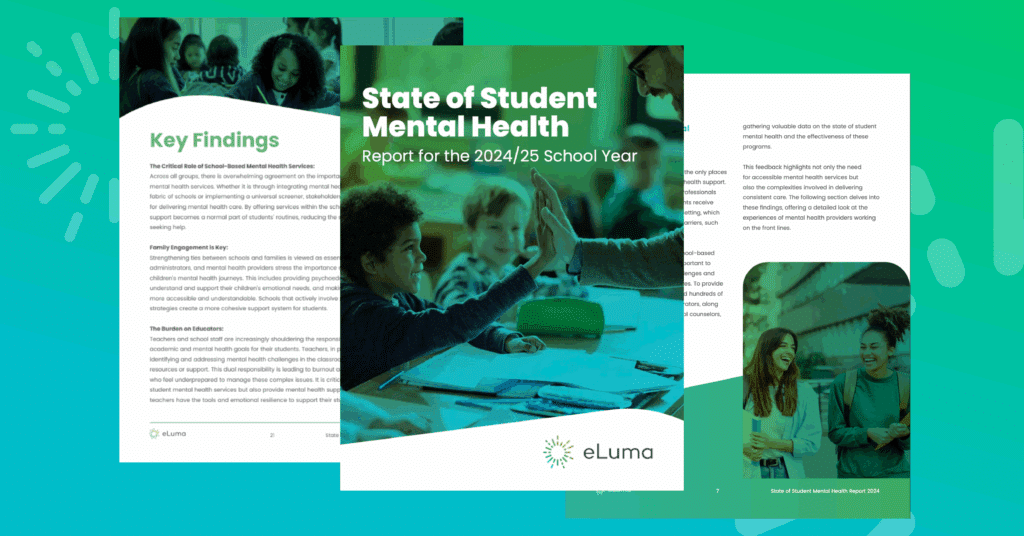The Alarming Trends in the 2024 State of Student Report and How We Must Respond
The findings from the 2024 State of Student Mental Health Report confirm what school leaders see every day: more students are struggling, and the need for mental health support is growing faster than most schools can manage.
Anxiety, depression, and other mental health concerns are showing up in classrooms. These challenges impact students’ emotions, academics, behavior, and attendance. Schools want to help, but many are facing serious limitations when it comes to staff, funding, and consistent access to care.
At eLuma, we believe no student should go without the support they need to succeed. That belief has guided our work from the beginning. That’s why our founder, Jeremy Glauser, started the company and continues to work closely with national mental health leaders like the Kennedy Forum’s School-Based Industry Council to champion scalable, sustainable solutions for mental health in schools.
By working with these leading initiatives, we’re helping create sustainable solutions and ensure every student has the support they need to succeed.
This year’s State of Student Mental Health Report includes insights from more than 500 educators, administrators, school counselors, and mental health providers. It offers a clear look at the realities schools are facing and a practical guide to the steps we can take next.
Key Takeaways
- Student mental health in school is reaching crisis levels, impacting learning, behavior, and long-term outcomes.
- Most schools lack the staffing and systems to keep up with growing mental health needs.
- Early intervention, expanded access to care, and staff training are critical to improving outcomes.
- Virtual mental health services can help schools close gaps and reach more students consistently.
- Engaging families and building a schoolwide culture of support leads to better student well-being and academic success.

A Generation in Crisis: What the Data Shows
Mental Health Concerns Are on the Rise
According to the National Institute of Mental Health, suicide rates have increased by 24 percent. Mental health conditions now account for over 23 percent of the total disease burden for adolescents.
In real terms, students are facing:
These issues are not isolated. They affect classrooms and school communities.
Too Few Providers, Too Many Needs
Nearly 60 percent of students with major depression go untreated. And only 10 percent of mental health professionals say care is well coordinated. Many school-based professionals are doing all they can but are stretched thin, and the system is falling behind.
When students don’t receive timely care, their mental health declines, and so does their ability to learn.
Gaps in Care Lead to Missed Opportunities
Students with inconsistent attendance often miss out on support entirely. In rural and underserved areas, limited provider availability makes it even harder to connect students to care before they slip through the cracks.
Administrator Burnout Is Growing
Nearly half of school leaders say they do not feel confident in their ability to support student mental health. Competing priorities, staff shortages, and limited training add pressure to an already heavy load.

From Problem to Plan: Solutions for Mental Health in Schools
The State of Student Mental Health Report doesn’t just highlight the crisis. It provides actionable solutions that schools can enact to address these critical challenges.
Here’s how this report can help provide solutions for mental health in schools:
1. Start with What You Have: Resource Mapping
Before hiring more staff or launching new programs, schools can benefit from looking closely at what is already in place. Resource mapping helps districts:
- Identify existing supports, both in-school and community-based
- Uncover gaps and overlaps in services
- Align mental health and academic supports more effectively
By improving coordination and referral pathways, schools can stretch existing resources further without increasing the burden on their teams.
2. Strengthen and Support Your Staff
Mental health support should not be the sole responsibility of a few professionals. The report emphasizes the value of professional development across the entire school community. When educators are trained to recognize and respond to mental health needs, students receive earlier and more effective support.
Wellness initiatives, peer collaboration, and clear systems for escalation also help reduce staff burnout and promote retention.
3. Expand Access with Virtual Services
When there are not enough on-site providers, virtual mental health services can be a game-changer. With a trusted partner like eLuma, schools can:
- Increase provider capacity
- Shorten waitlists
- Offer consistent, high-quality care to every student who needs it
This approach is especially valuable in regions that are difficult to staff or where local care options are limited.
4. Engage Families as Key Partners
Students benefit when schools and caregivers work together. The report recommends:
- Providing families with psychoeducation and practical tools
- Encouraging consistent communication and collaboration
- Building culturally responsive systems that reflect and respect diverse communities
When families feel supported and informed, they are better equipped to help students thrive both in and out of school.

Download the Full Report and Take Action
The 2024-25 State of Student Mental Health Report is more than a data summary. It’s a roadmap for real solutions. Whether your school is focused on building staff capacity, improving early intervention, or better engaging families, this report can help guide the way.
Don’t wait for a crisis. Download the 2024-25 State of Student Mental Health Report and take the first step toward stronger systems of care.
When schools lead with mental health, students have the chance to thrive in school and beyond. Together, we can ensure that no student faces mental health challenges alone.

